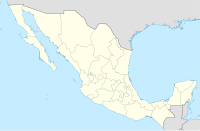Acapulco International Airport
General Juan N. Álvarez International Airport Aeropuerto Internacional General Juan N. Álvarez | |||||||||||||||
|---|---|---|---|---|---|---|---|---|---|---|---|---|---|---|---|
 | |||||||||||||||
| Summary | |||||||||||||||
| Airport type | Public | ||||||||||||||
| Operator | Grupo Aeroportuario Centro Norte | ||||||||||||||
| Serves | Acapulco | ||||||||||||||
| Location | Acapulco, Guerrero, Mexico | ||||||||||||||
| Elevation AMSL | 13 ft / 4 m | ||||||||||||||
| Coordinates | 16°45′21.7″N 99°45′05.8″W / 16.756028°N 99.751611°W | ||||||||||||||
| Map | |||||||||||||||
| Runways | |||||||||||||||
| |||||||||||||||
| Statistics (2019) | |||||||||||||||
| |||||||||||||||
Source: Grupo Aeroportuario Centro Norte[1] | |||||||||||||||
Acapulco International Airport, officially General Juan N. Álvarez International Airport (IATA: ACA, ICAO: MMAA), is the main airport of Acapulco, Guerrero, Mexico, located 26 km (16 miles) from the city.
In 2018, the airport handled 739,120 passengers, and in 2019 it handled 875,315 passengers.[1]
Information
Because Acapulco has always been considered an important resort and recreation area, Acapulco International Airport has long been important in the development of tourism in southern Mexico. It is the largest international airport in the country's southern Pacific region, and one of the largest air facilities in Mexico. Frequent flights are available daily from Mexico City International Airport in Mexico City as well as less frequent flights from other Mexican, American, and Canadian cities. The airport can accommodate jets up to the size of the Boeing 747.
This international airport is one of the top 15 airports in Mexico in terms of operations, receiving many international charter flights.
The facility has many services for passengers, including restaurants, VIP lounges, and several gates equipped with jetways, and is divided in two terminals, The Passenger terminal, serving all scheduled flight and all airlines (domestic and international) and the General Aviation terminal, which is a 1960s circular building.
The airport was named after Juan N. Álvarez Hurtado, a Mexican military who was instrumental in most of the armed conflicts in the beginning of Mexican independence, Governor of Guerrero and President of Mexico.
Airlines and destinations



| Airlines | Destinations |
|---|---|
| Aeromar | Mexico City |
| Aeroméxico | Mexico City (suspended)[2] |
| Aeroméxico Connect | Mexico City (suspended)[2] |
| Air Transat | Seasonal: Montréal–Trudeau |
| American Eagle | Seasonal: Dallas/Fort Worth |
| Interjet | Cancún (suspended),[3] Mexico City, Toluca/Mexico City (suspended)[3] |
| Magni | Monterrey |
| Sunwing Airlines | Seasonal: Montréal–Trudeau, Toronto–Pearson |
| TAR Aerolineas | Guadalajara, Querétaro |
| United Express | Seasonal: Houston–Intercontinental |
| VivaAerobus | Monterrey |
| Volaris | Guadalajara (suspended),[4] Mexico City (suspended),[4] Tijuana |
Traffic statistics
Passengers
List of passengers per year since 2001.[5][6]
| Year | Total passengers | % change | Domestic Passengers |
% change | International Passengers |
% change |
|---|---|---|---|---|---|---|
| 2001 | 940 197 | 569 195 | 371 002 | |||
| 2002 | 793 420 | 523 172 | 270 248 | |||
| 2003 | 774 349 | 527 208 | 247 141 | |||
| 2004 | 821 301 | 542 437 | 278 864 | |||
| 2005 | 880 190 | 554 988 | 325 202 | |||
| 2006 | 994 393 | 638 543 | 355 850 | |||
| 2007 | 1 057 332 | 740 289 | 317 043 | |||
| 2008 | 1 087 974 | 818 671 | 269 303 | |||
| 2009 | 839 048 | 636 418 | 202 630 | |||
| 2010 | 736 878 | 547 420 | 189 458 | |||
| 2011 | 596 326 | 495 018 | 101 308 | |||
| 2012 | 546 951 | 486 268 | 60 683 | |||
| 2013 | 617 079 | 560 945 | 56 134 | |||
| 2014 | 631 570 | 576 042 | 55 528 | |||
| 2015 | 730 382 | 677 698 | 52 684 | |||
| 2016 | 718 493 | 664 418 | 54 075 | |||
| 2017 | 673 809 | 631 829 | 53 295 | |||
| 2018 | 739 120 | 681 587 | 57 533 | |||
| 2019 | 875 315 | 814 636 | 60 679 |
Busiest routes
| Rank | City | Passengers | Ranking | Airline |
|---|---|---|---|---|
| 1 | 288,684 | Aeromar, Aeroméxico, Aeroméxico Connect, Interjet, Volaris | ||
| 2 | 43,477 | Volaris | ||
| 3 | 26,210 | Interjet | ||
| 4 | 22,920 | Magni, VivaAerobus | ||
| 5 | 20,970 | TAR, Volaris | ||
| 6 | 3,738 | Interjet | ||
| 7 | 3,266 | TAR | ||
| 8 | 131 |
See also
References
- ^ a b "OMA's Monthly Traffic Report". Grupo Aeroportuario Centro Norte. Retrieved 30 January 2020.
- ^ a b "Safety Precautions: COVID-19". Aeroméxico. June 2020. Retrieved 16 June 2020.
- ^ a b "Interjet limits its operation to 6 destinations". EnElAire (in Spanish). May 2020. Retrieved 6 May 2020.
- ^ a b "Routes that we are operating". Volaris. June 2020. Retrieved 15 June 2020.
- ^ "Investor Relations". Grupo Aeroportuario Centro Norte de México. January 2017. Retrieved 16 January 2017.
- ^ a b "Passenger's Traffic". Grupo Aeroportuario Centro Norte de México. January 2017. Archived from the original (XLS) on 22 December 2015. Retrieved 16 January 2017.
- ^ "Traffic Statistics by Airline" (in Spanish). Secretaría de Comunicaciones y Transportes. January 2020. Retrieved 9 March 2020.

